Compare
Overview
OpenAI o1 vs Gemini for math Comparison in different aspects of AI services with data mining from genuine user reviews & ratings, including: ALL,Interesting,Concise,Helpfulness,Correctness. AI store is a platform of genuine user reviews,rating and AI generated contents, covering a wide range of categories including AI Image Generators, AI Chatbot & Assistant, AI Productivity Tool, AI Video Generator, AI in Healthcare, AI in Education, AI in Lifestyle, AI in Finance, AI in Business, AI in Law, AI in Travel, AI in News, AI in Entertainment, AI for Kids, AI for Elderly, AI Search Engine, AI Quadruped Robot.
Reviews Comparison
Recommended Tags
-
MayZhou 2024-09-14 12:22To test OpenAI o1 model's ability of graduate-level machine learning & math, I tried to ask OpenAI o1 to solve the problem of "Use Newton method to calculate the exact value of \sqrt{2}. Provide Detailed proof step by step." OpenAI o1 actually gives me a very long detailed step-by-step proof, which is much detailed and longer than GPT4o or GPT4o-mini. The complete response is very long and I just summarized the detailed steps of the reasoning here. Overall, I think OpenAI o1 can provide more accurate responses than previous GPT4o' answers. But the response usually is very long and there are a lot of top-down break-down, which makes the final result correct but sometimes hard to understand and follow. OpenAI o1 breaks down the machine learning math problem into these steps: ### Step 1: Define the Function and Its Derivative ### Step 2: Derive the Newton's Method Iteration Formula ### Step 3: Choose an Initial Approximation ### Step 4: Perform Iterations ### Step 5: Understanding the Result Each iteration yields a rational approximation that gets closer to ( \sqrt{2} ): - Iteration 1: ( x_1 = \dfrac{3}{2} = 1.5 ) - Iteration 2: ( x_2 = \dfrac{17}{12} \approx 1.4167 ) - Iteration 3: ( x_3 = \dfrac{577}{408} \approx 1.41422 ) - Iteration 4: ( x_4 = \dfrac{667,217}{471,632} \approx 1.41421 ) ### Conclusion Using Newton's method with the function ( f(x) = x^2 - 2 ) and starting approximation ( x_0 = 1 ), we generate a sequence ( { x_n } ) defined by: [ x_{n+1} = \frac{1}{2} \left( x_n + \frac{2}{x_n} \right) ] This sequence converges to ( \sqrt{2} ) as ( n ) approaches infinity. ### Final Answer By applying Newton's method to the equation ( x^2 - 2 = 0 ), we find that ( \sqrt{2} ) is the limit of the sequence: [ x_{n+1} = \dfrac{1}{2} \left( x_n + \dfrac{2}{x_n} \right) ] Starting from ( x_0 = 1 ), each iteration gives a rational approximation of ( \sqrt{2} ). Although we cannot express ( \sqrt{2} ) exactly using Newton's method (since it's irrational), the method provides increasingly accurate approximations.




-
ai4science03 2024-09-13 08:44Finally, OpenAI released o1 mdoel with stronger reasoning ability. And I looked through the detailed comparison of a math solving results on their website and the comparison between GPT4o vs OpenAI o1-preview on this Algebra problem. For the math question as the in the prompt, o1 uses a chain of thought when attempting to solve a problem, which is similar to how a human may think for a long time before responding to a difficult question. o1 response actually break down the question into a few steps: "Understanding the Given Information", "Defining a New Polynomial", "Properties of q(x)", "Constructing s(x)", "Matching Coefficients". Finding Additional Solutions and finally reaching Conclusion. The additional real numbers x satisfying p(1/x) = x^{2} are x=\frac{1}{n!} or -\frac{1}{n!}. Overall, the reasoning ability is quite complex compared to previous version, so it's helpful and the answers are correct.
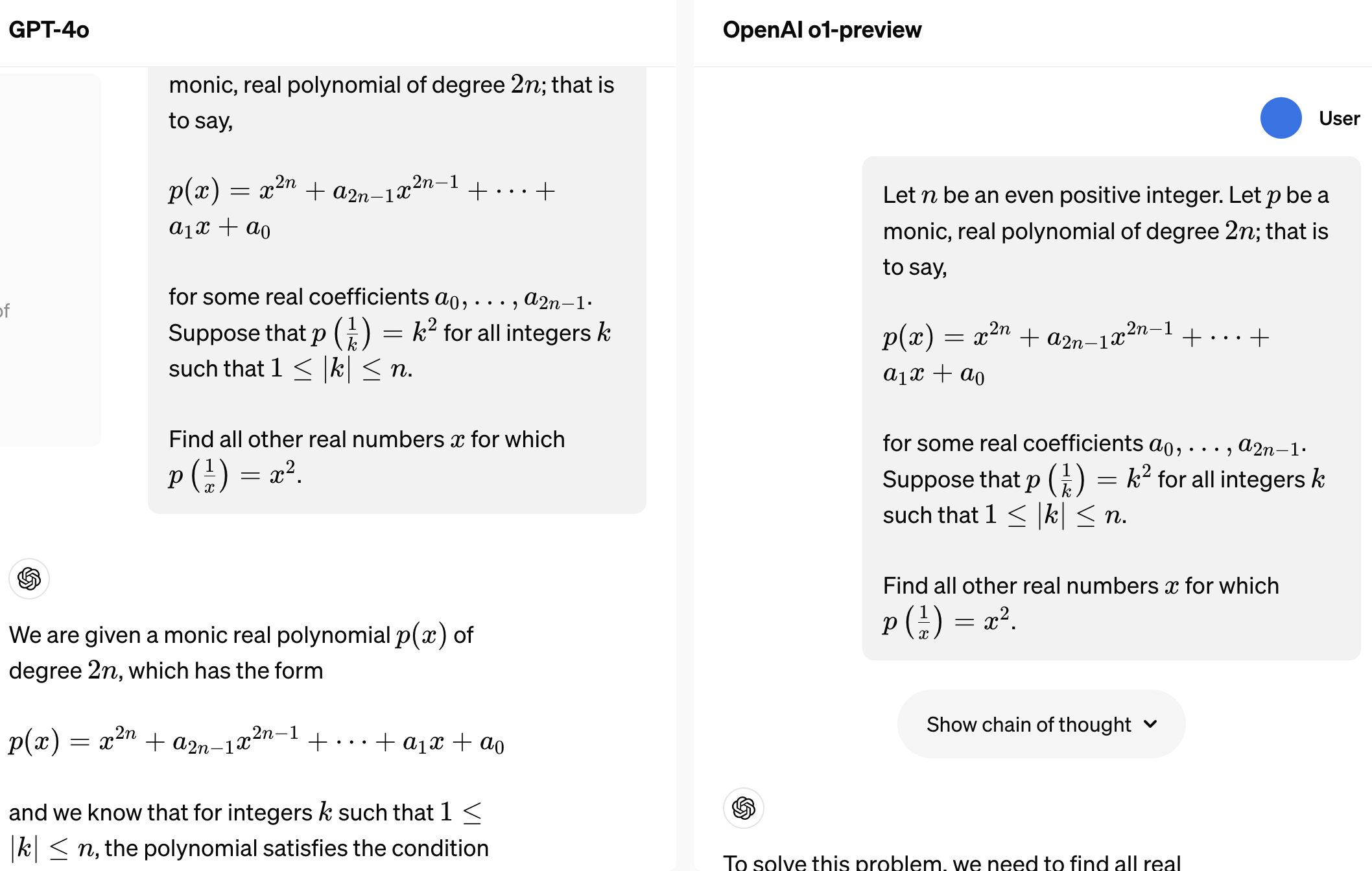
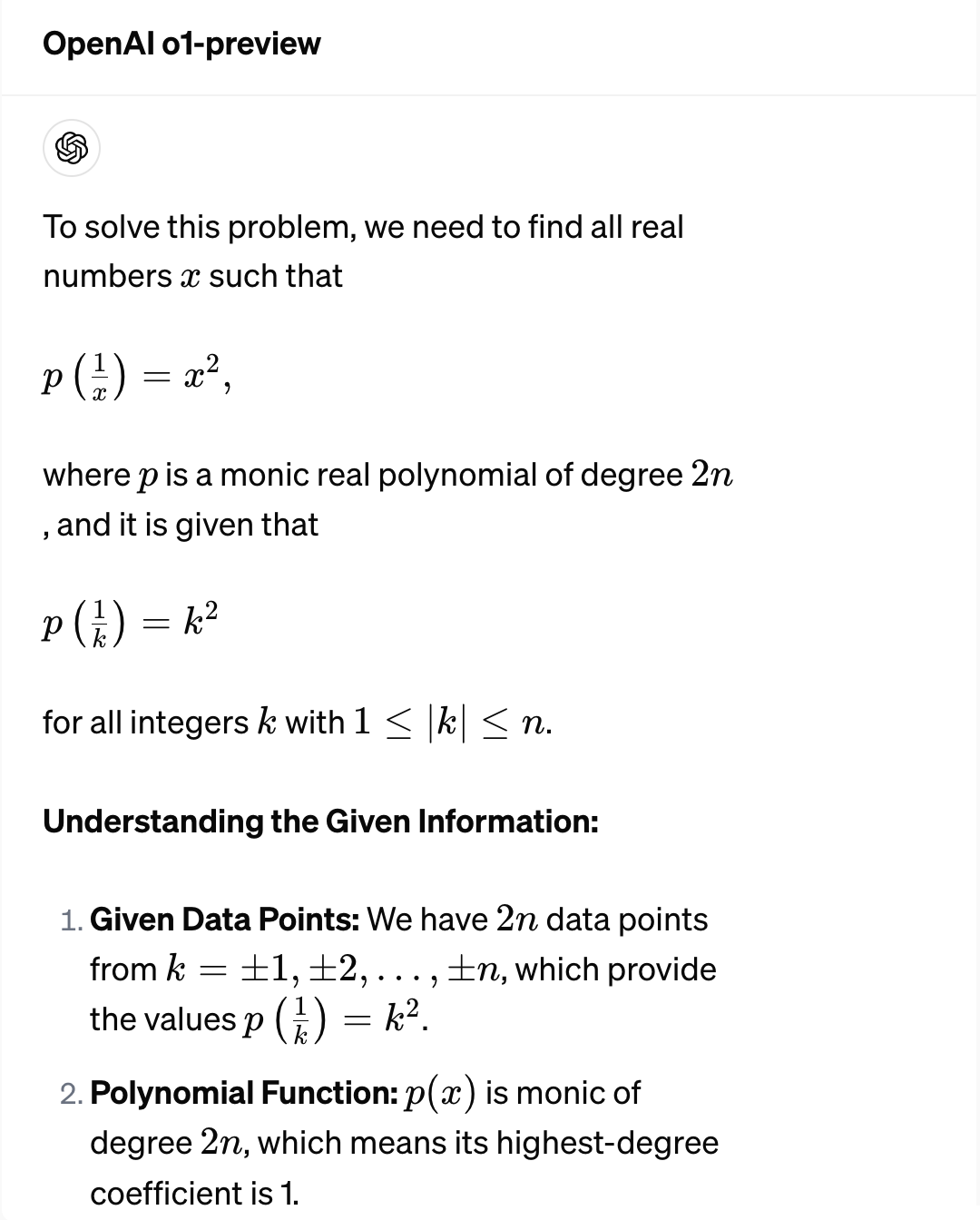
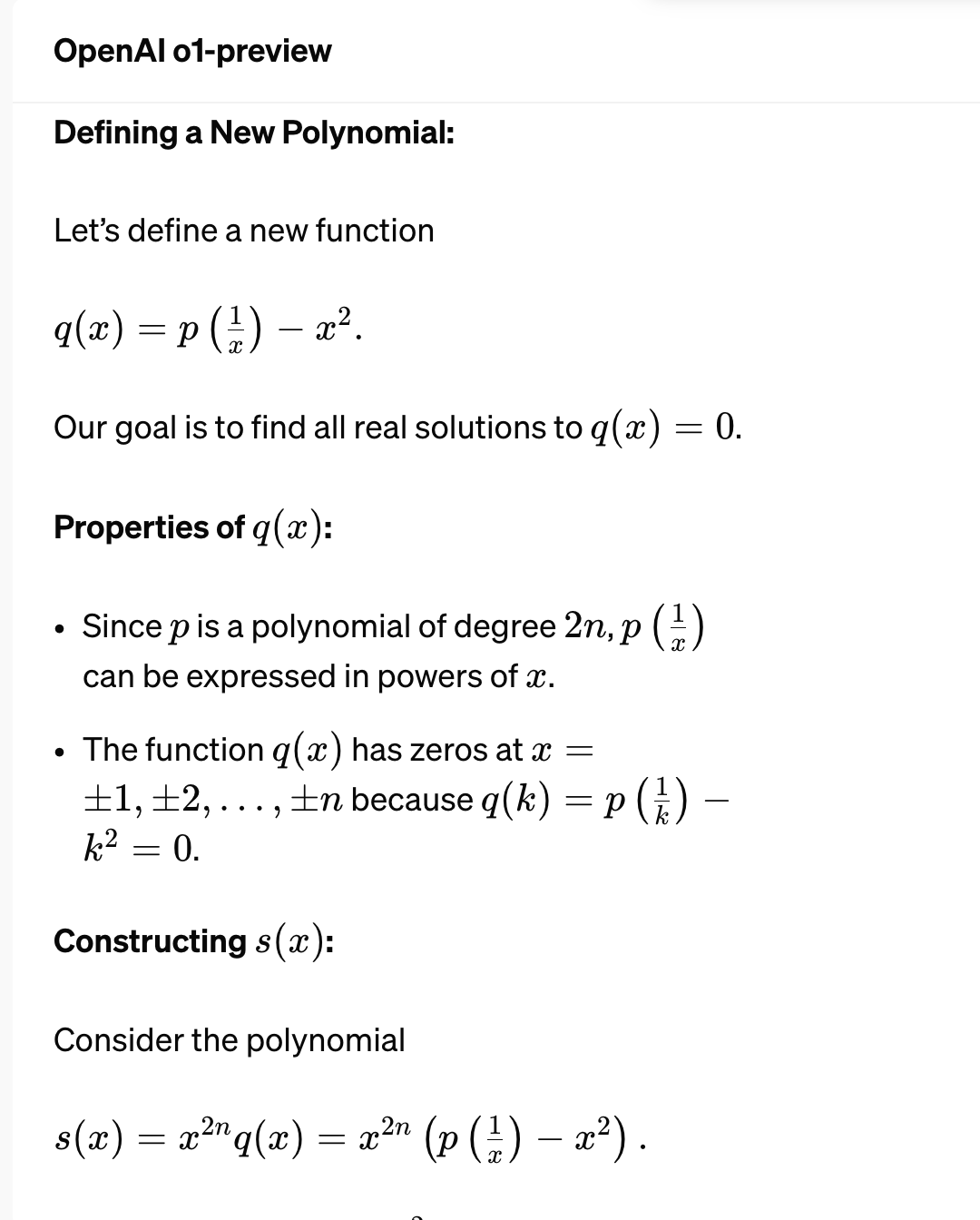
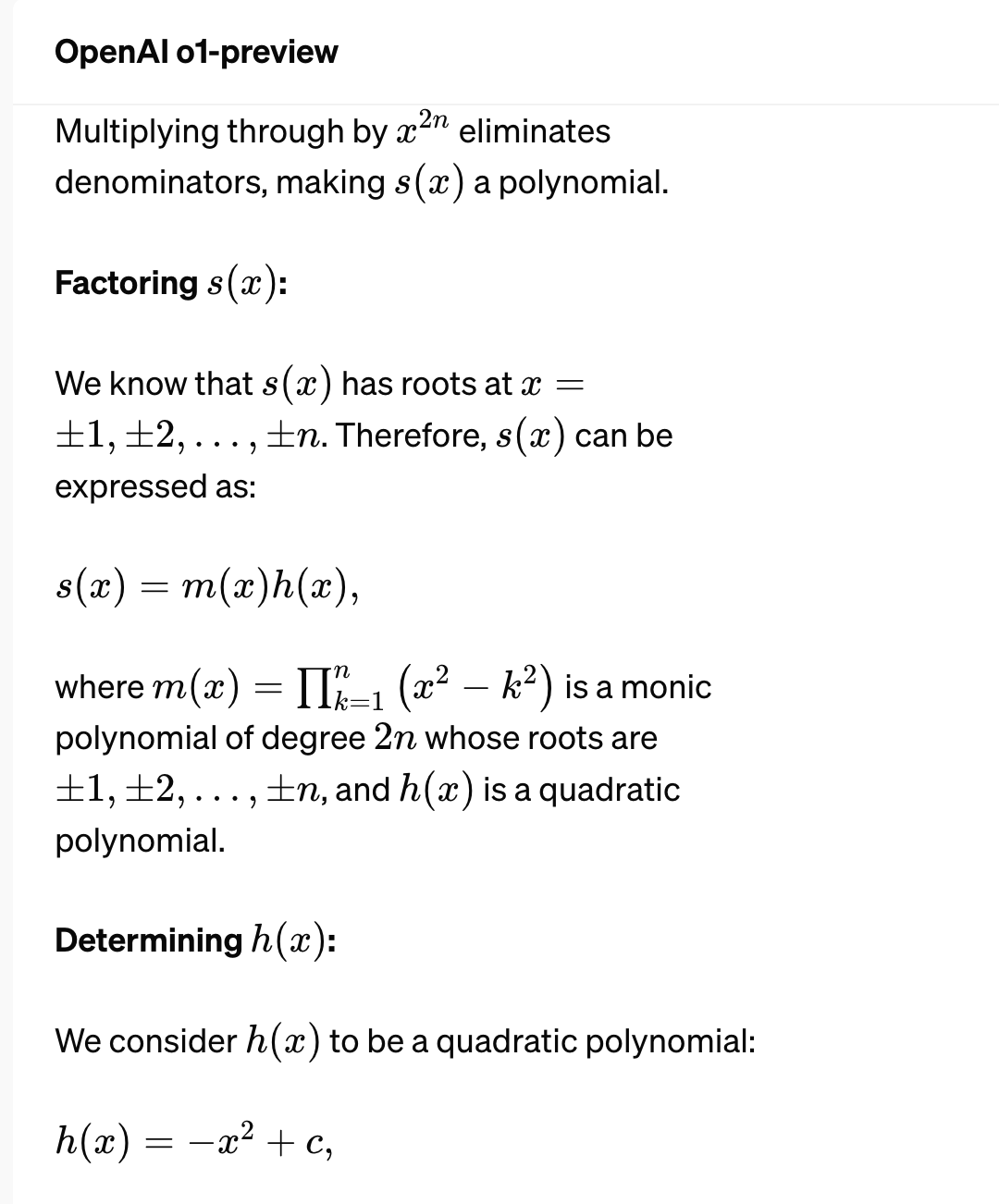
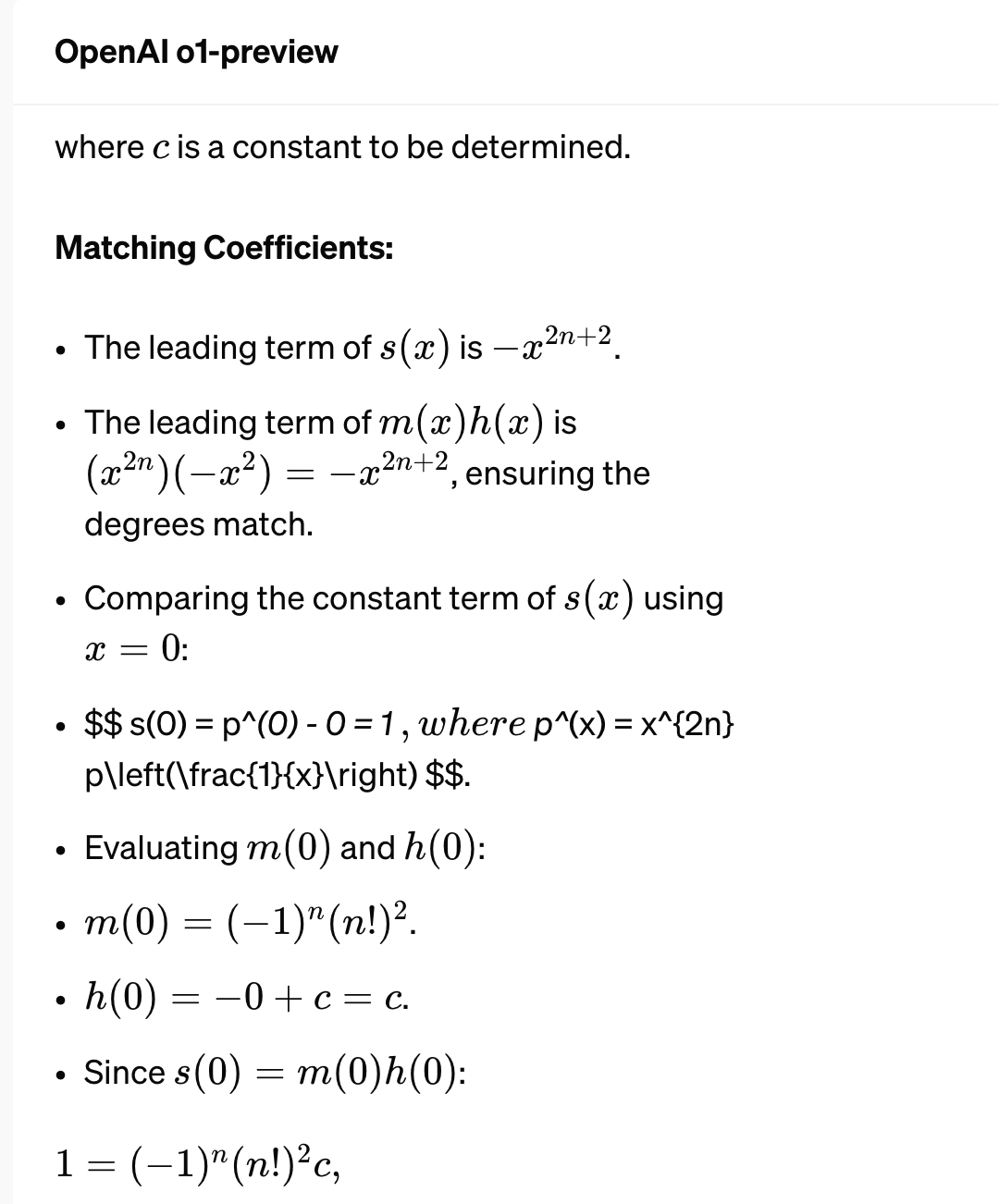

-
MayZhou 2024-09-14 12:33I asked Gemini to solve this graduate-level machine learning math problem "Use Newton method to calculate the exact value of \sqrt{2}. Provide Detailed proof step by step". And Gemini provides correct and concise answers to this question. It breaks down into a few steps: 1. Initial Guess, which is to Let's start with an initial guess, say x 0=1. This is a reasonable guess since 1^2 is close to 2. 2. Newton's Method Formula 3. Iterations 4. Convergence and get the conclusion Newton's method converges quadratically, which means that the number of correct digits approximately doubles with each iteration. As we continue iterating, we'll get closer and closer to the exact value of \sqrt{2}.
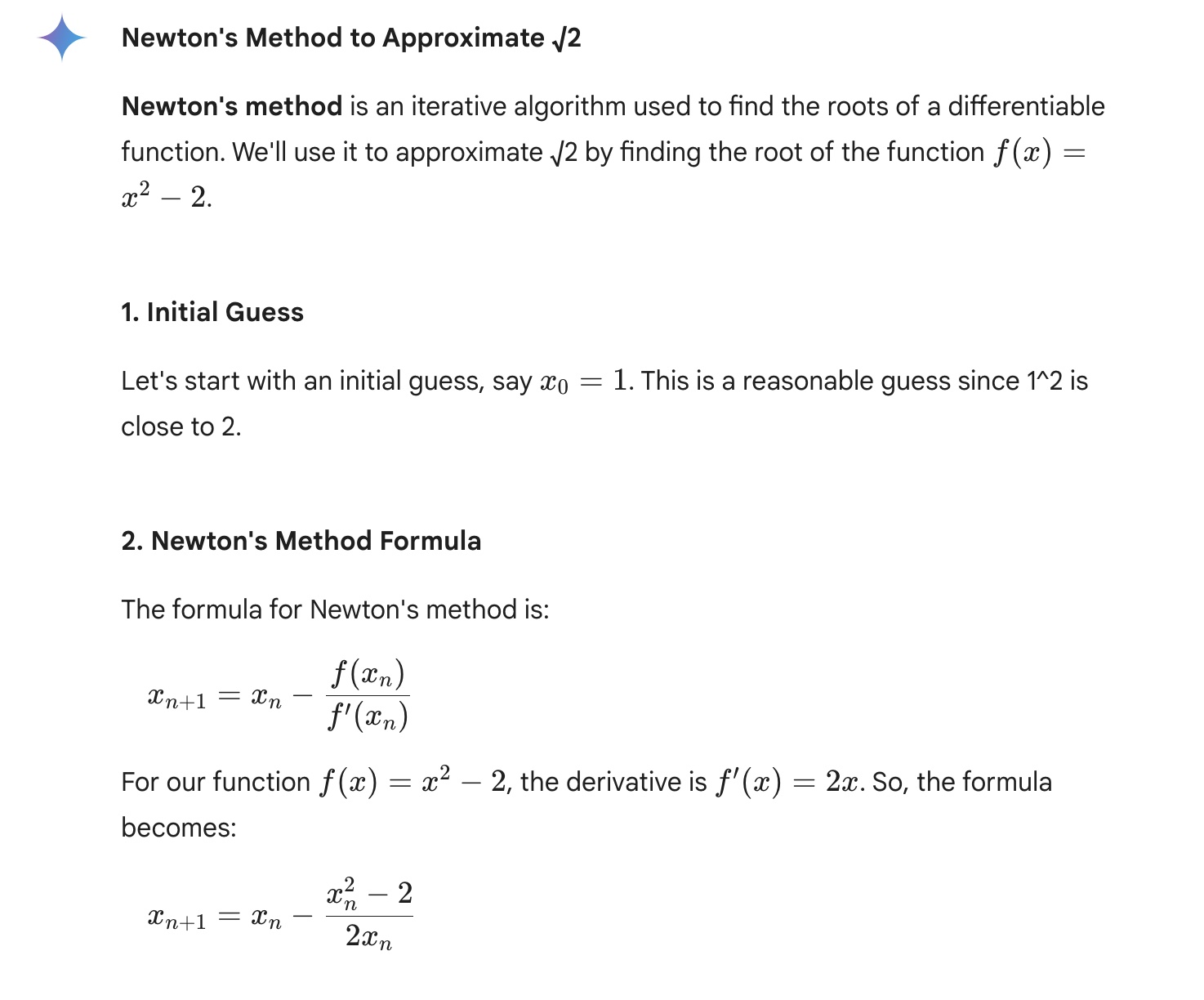
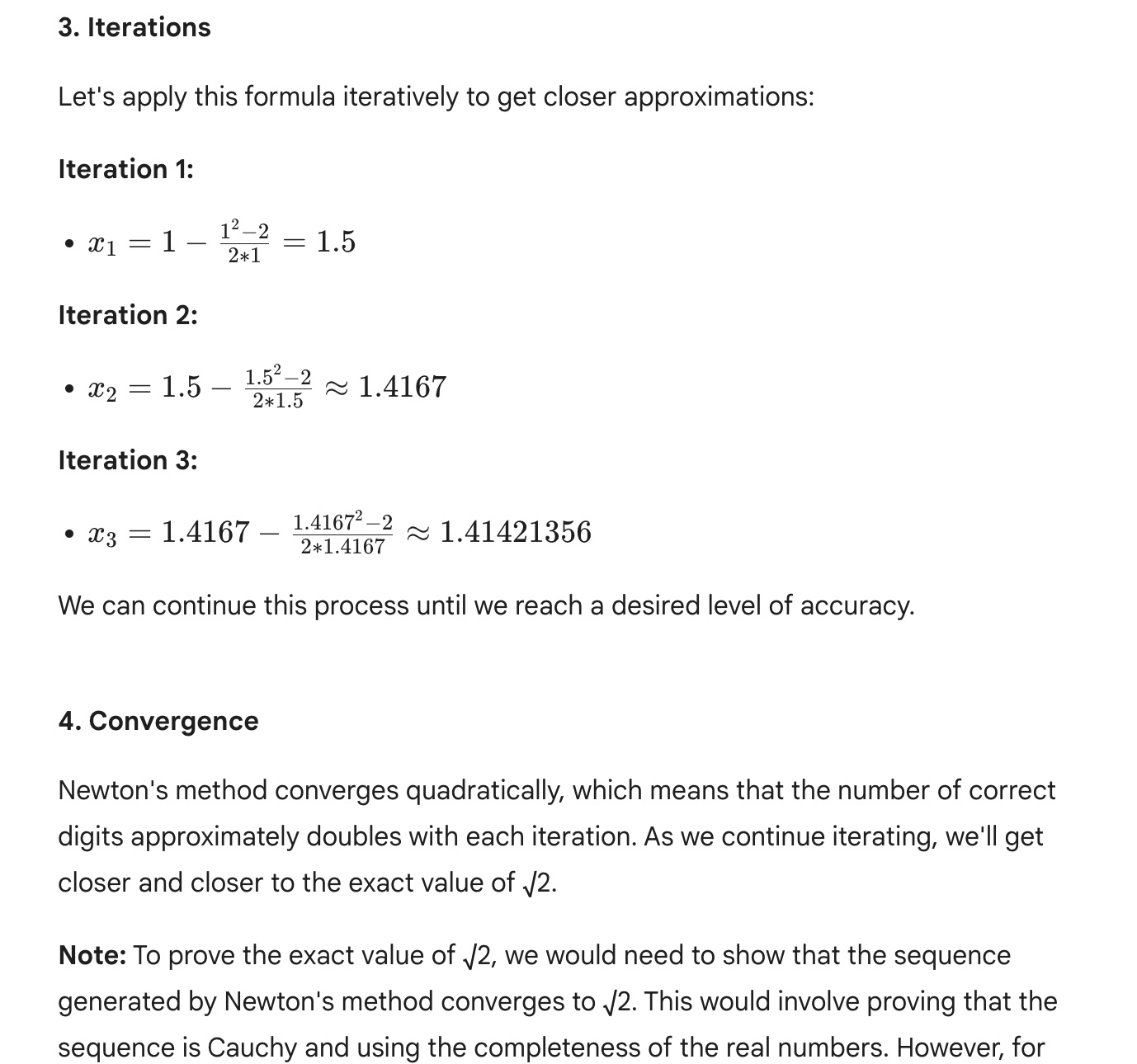
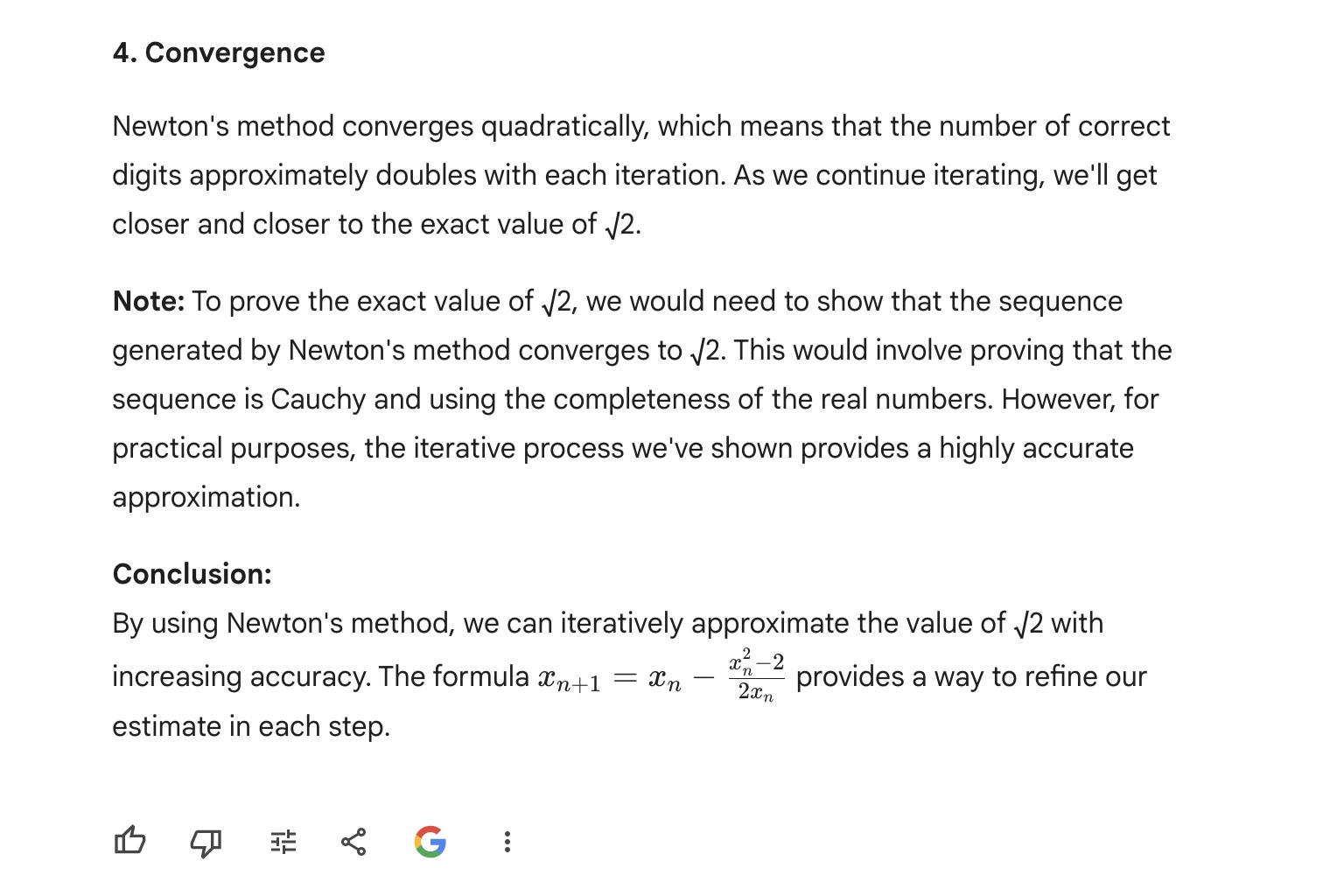
-
MayZhou 2024-09-14 12:27Gemini provides the correct answer to my high-school level math question about calculus "Calculate the first order derivative of function f(x)=\frac{1}{x} at the point x=2.". It uses the power rule to get the derivative function f'(x) and calculate its value at point x=2. And gets the correct answer -1/4. The answer is helpful, concise and easy to understand.
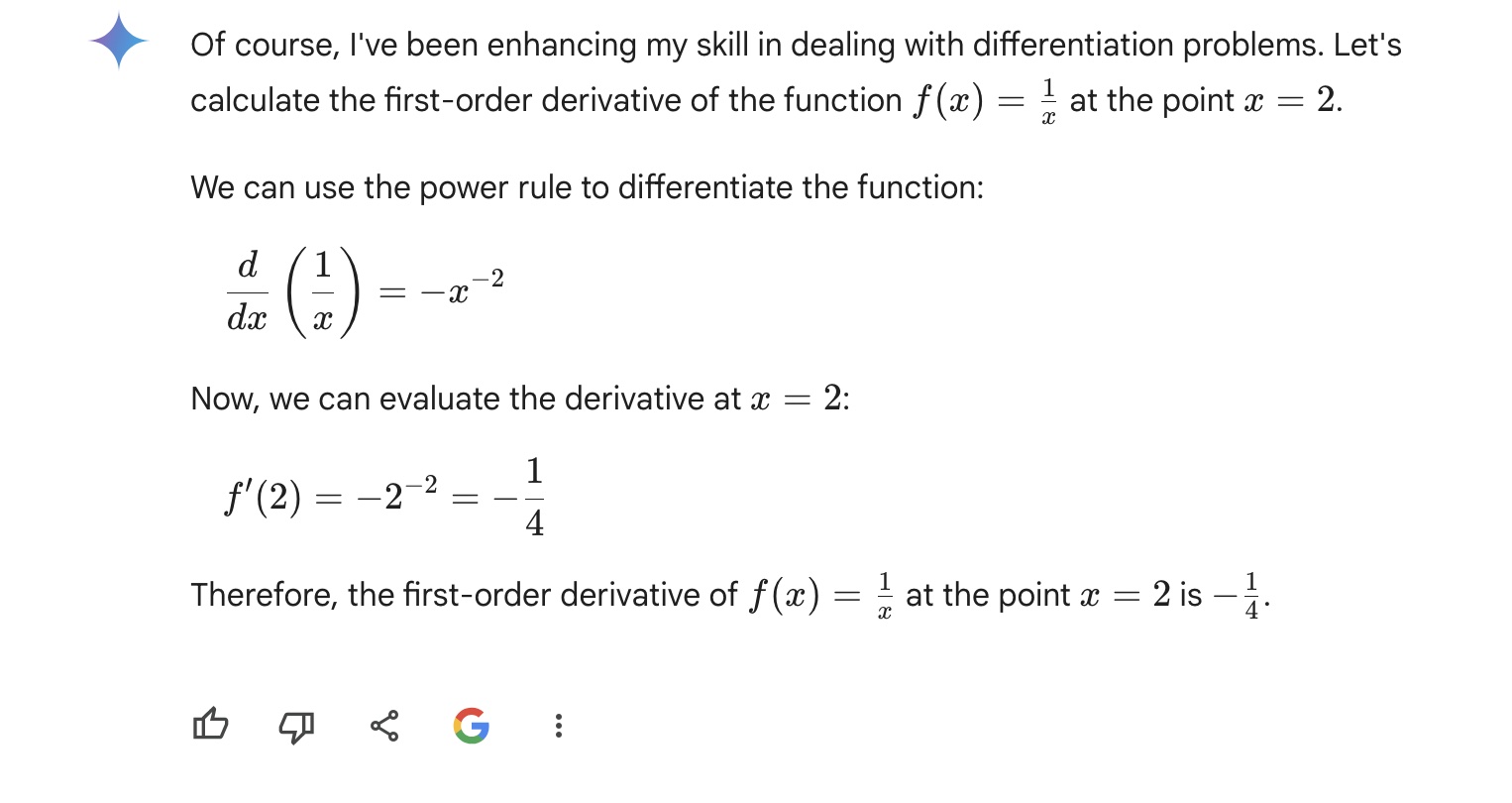
-
ai4science03 2024-09-09 12:44Gemini gives the correct answer of the math problem of calculating differentiation of function. It applies the step by step thinking and firstly outlines the method it uses to solve the differentiation "use the sum rule and the derivatives of individual functions". Then it gives detailed proof as follows: To find the derivative of f(x) = e^x + log(x) + sin(x), we'll use the sum rule and the derivatives of individual functions. The sum rule states that the derivative of a sum of functions is the sum of the derivatives of the individual functions. Here are the derivatives of the individual functions: Derivative of e^x: d/dx(e^x) = e^x Derivative of log(x): d/dx(log(x)) = 1/x Derivative of sin(x): d/dx(sin(x)) = cos(x) Applying the sum rule, we get: f'(x) = d/dx(e^x) + d/dx(log(x)) + d/dx(sin(x)) f'(x) = e^x + 1/x + cos(x) Therefore, the derivative of f(x) = e^x + log(x) + sin(x) is f'(x) = e^x + 1/x + cos(x).

-
ai4science03 2024-09-09 12:25Gemini gives the correct answer to the quadratic equation x^2+5x+6=0 and it's using the step by step thinking method, which is very similar to the results from Claude, but different from the factoring methods of ChatGPT. Overall, the response from Gemini on solving this math problem is correct and helpful.
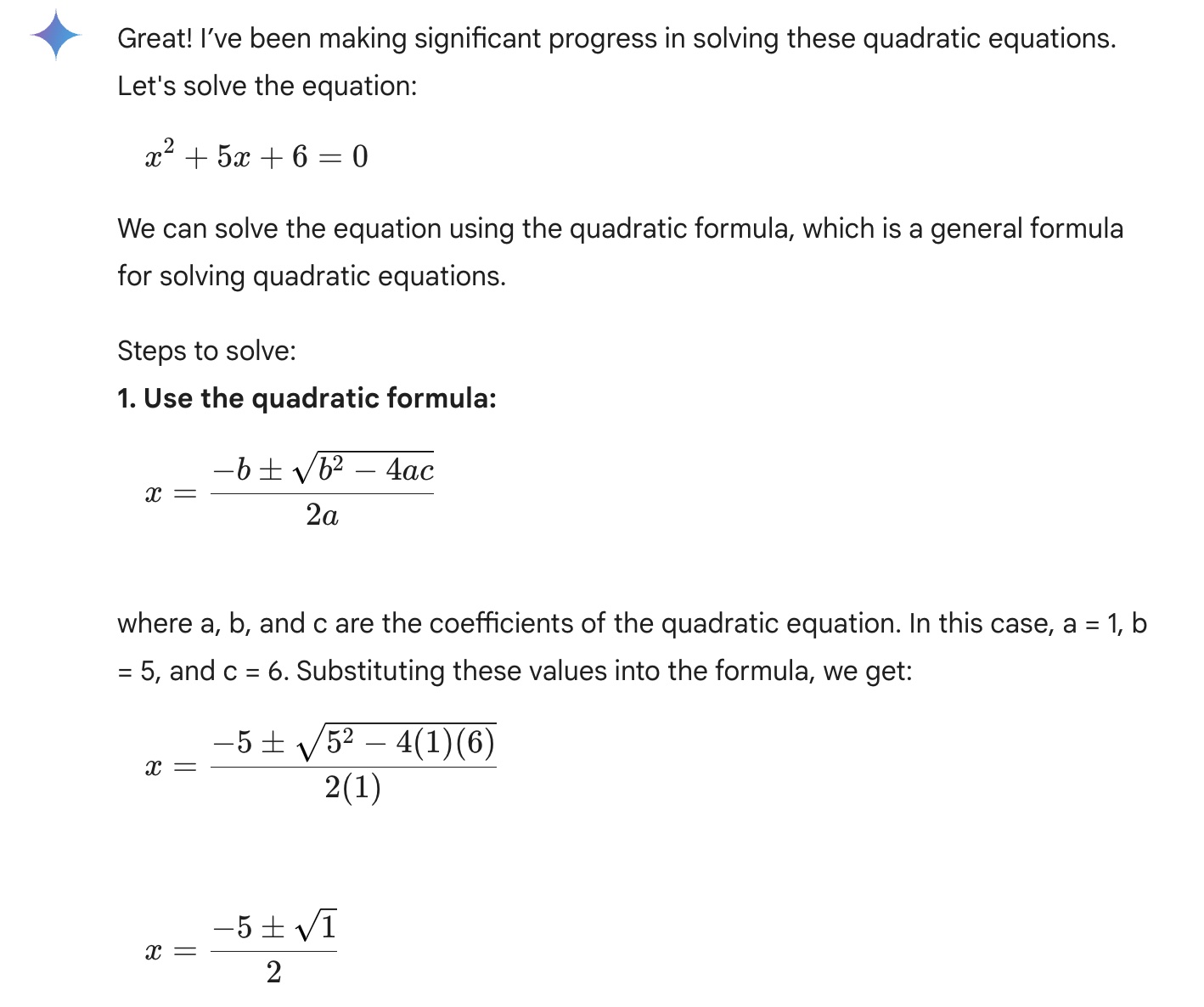
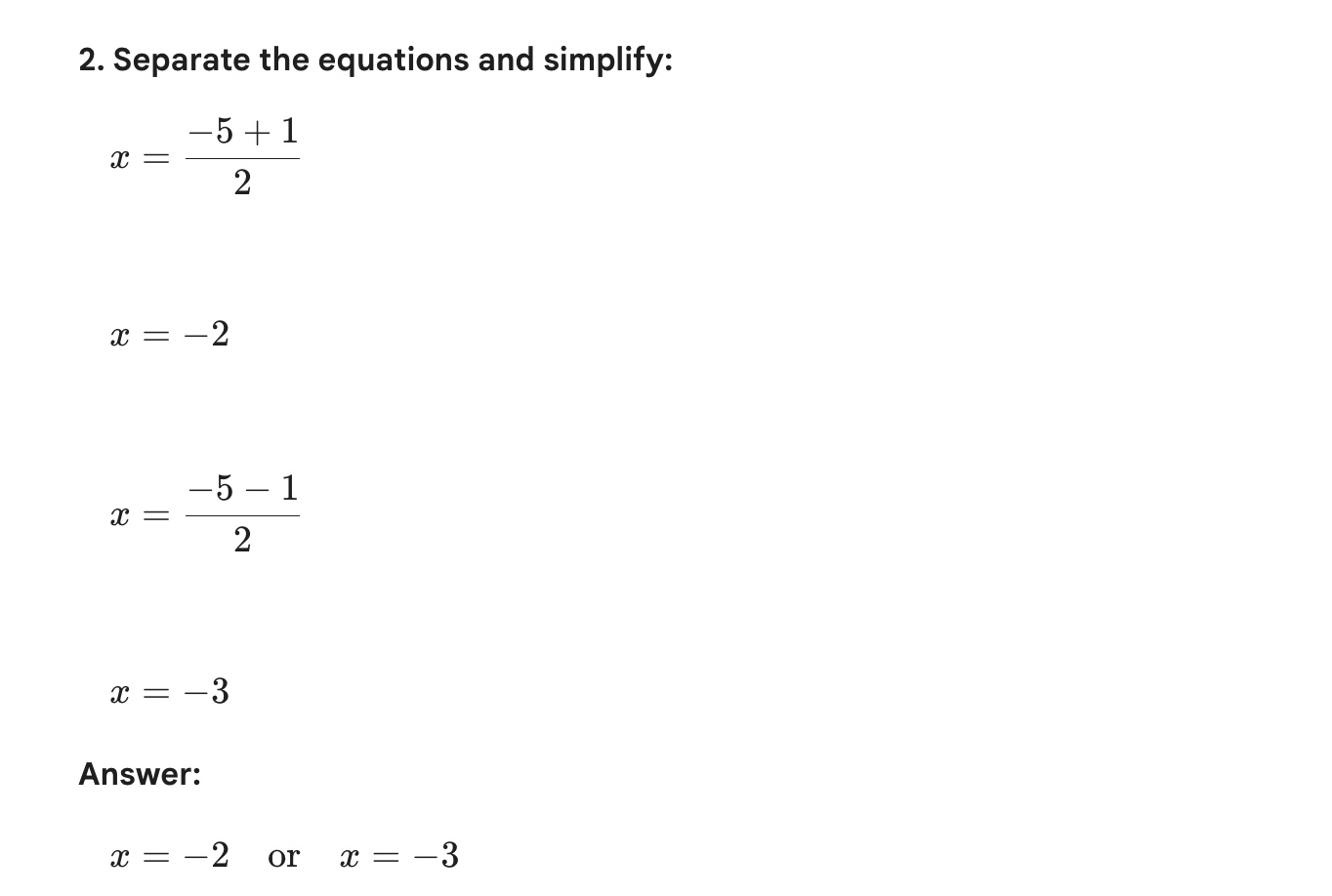
-
Community
-
Please leave your thoughts on the best and coolest AI Generated Images.
-
Please leave your thoughts on free alternatives to Midjourney Stable Diffusion and other AI Image Generators.
-
Please leave your thoughs on the most scary or creepiest AI Generated Images.
-
We are witnessing great success in recent development of generative Artificial Intelligence in many fields, such as AI assistant, Chatbot, AI Writer. Among all the AI native products, AI Search Engine such as Perplexity, Gemini and SearchGPT are most attrative to website owners, bloggers and web content publishers. AI Search Engine is a new tool to provide answers directly to users' questions (queries). In this blog, we will give some brief introduction to basic concepts of AI Search Engine, including Large Language Models (LLM), Retrieval-Augmented Generation(RAG), Citations and Sources. Then we will highlight some majors differences between traditional Search Engine Optimization (SEO) and Generative Engine Optimization(GEO). And then we will cover some latest research and strategies to help website owners or content publishers to better optimize their content in Generative AI Search Engines.
-
We are seeing more applications of robotaxi and self-driving vehicles worldwide. Many large companies such as Waymo, Tesla and Baidu are accelerating their speed of robotaxi deployment in multiple cities. Some human drivers especially cab drivers worry that they will lose their jobs due to AI. They argue that the lower operating cost and AI can work technically 24 hours a day without any rest like human will have more competing advantage than humans. What do you think?
-
Please leave your thoughts on whether human artists will be replaced by AI Image Generator. Some similar posts on other platforms including quora and reddit. Is art even worth making anymore, Will AI art eventually permanently replace human artists, Do you think AI will ever replace artists, Do people really think that replacing artists with ai is a good idea

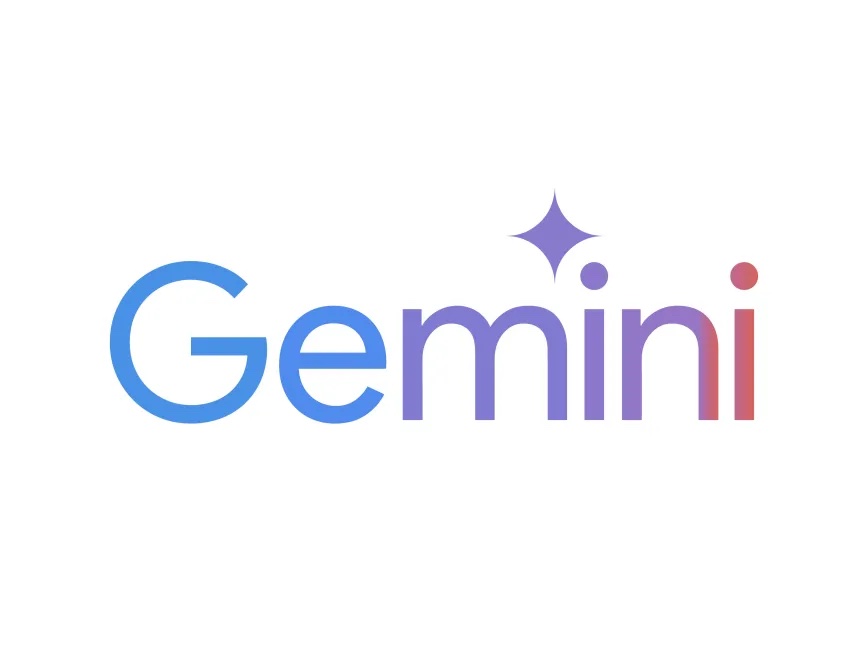
Reply